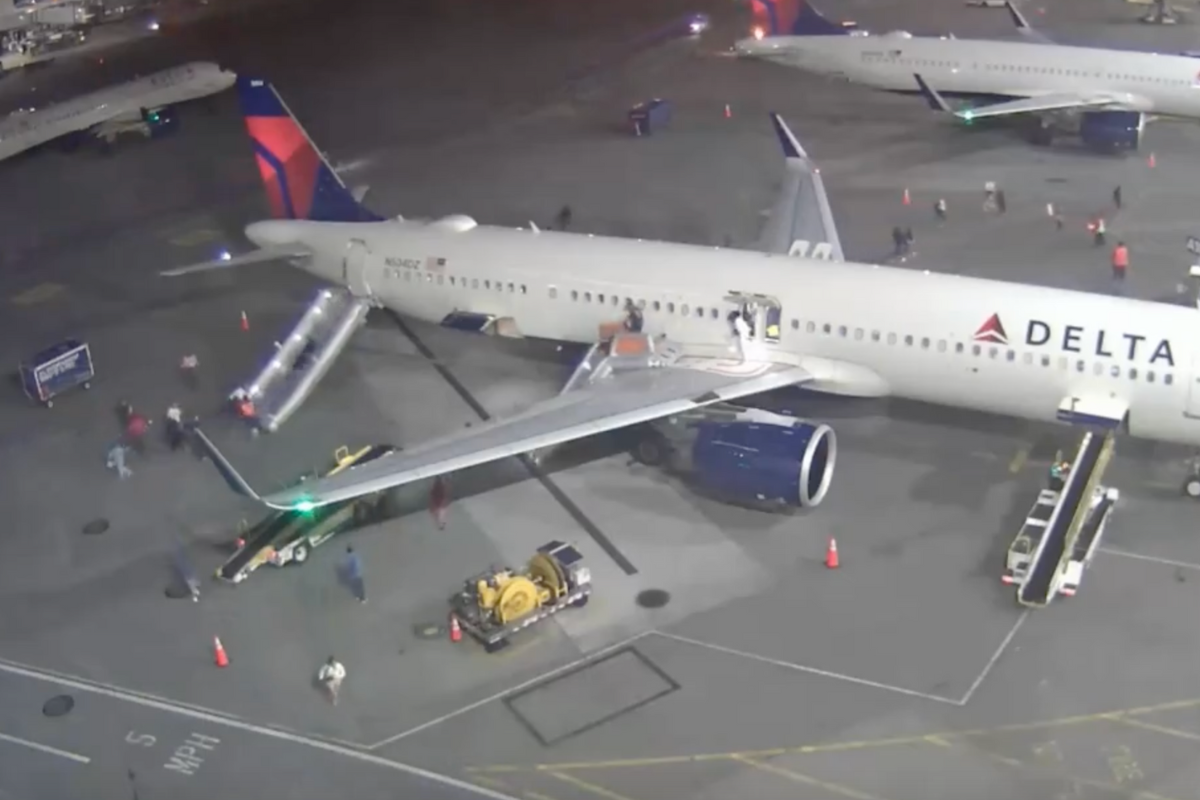
New surveillance video has emerged of the chaotic emergency response and evacuation of a Delta Air Lines jet at Seattle Tacoma Airport last week after sparks, flames, and smoke started to come out the nose of the Airbus A321neo aircraft.
Last Monday, passengers onboard Delta Flight 604 were forced to evacuate the plane via emergency slides and the emergency overwing exits shortly after the aircraft had arrived at the gate.
The one-year-old aircraft had just arrived in Seattle following a six-hour flight from Cancun, and the jetty was already being attached to the front left-hand door when sparks started to come out of the ground electrical connection on the nose of the plane.
In new video surveillance footage obtained by local news station KOMO, the chaotic emergency response and evacuation have been observed for the first time.
From the time that the first sparks started to be emitted from the nose, it took around 1 minute and 20 seconds before the evacuation started. Flight attendants opened both rear doors and deployed the emergency slides while passengers opened two sets of overwing emergency exits on either side of the aircraft.
The first passenger emerged from the planes nearly 30 seconds later, initially from the overwing exits, before the evacuation got underway at the rear emergency exits.
The last of 189 passengers onboard was seen leaving the aircraft around a minute and a half later, putting the total evacuation time at around two minutes.
It took around five minutes for the first airport fire brigade vehicle to show up at the scene, by which time the sparks had already stopped.
In a statement, a spokesperson for Delta Air Lines said the Captain ordered an evacuation “out of an abundance of caution”. The incident is still under investigation, but attention is focused on a fault with the ground power equipment rather than the aircraft.
The Airbus A321neo comes with various emergency exit layouts depending on the capacity onboard. In the case of Delta, its A321neos are fitted with four full-sized emergency exits – two at the front and two at the very rear, as well as four overwing emergency exits – two on either side of the aircraft.
Some airlines also have an additional set of mid-cabin emergency exit doors and depending on the configuration, there are options to have one or two overwing emergency exits on either side of the aircraft.
Airbus calls this highly customisable emergency exit configuration ‘Cabin Flex’. This is similar to how Boeing 737MAX aircraft are sometimes fitted with mid-cabin exit door plugs like the one which blew out on Alaska Flight 1282 in January.
Matt’s take
Of note in this latest evacuation was the number of passengers yet again evacuating the aircraft with their hand luggage. This evacuation was, however, non-standard and many passengers would have likely already been standing up in the aisles with their hand luggage when the evacuation was ordered.
At that point, hand luggage is already going to be blocking the aisles and exits, so you have to weigh up the risks of leaving hand luggage and potentially blocking the egress of other passengers against the risk of luggage being taken down the emergency slides, damaging the slides and hampering the evacuation.
Although the evacuation appears to take a long time to start, you have to consider the various check lists the pilots would have been working through before ordering an evacuation, as well as communicating to the flight attendants what was happening.
By the point the evacuation was ordered, the emergency exits would likely have been disarmed so the flight attendants would also have to re-arm the exits before commencing the evacuation.
Related
Mateusz Maszczynski honed his skills as an international flight attendant at the most prominent airline in the Middle East and has been flying ever since... most recently for a well known European airline. Matt is passionate about the aviation industry and has become an expert in passenger experience and human-centric stories. Always keeping an ear close to the ground, Matt's industry insights, analysis and news coverage is frequently relied upon by some of the biggest names in journalism.








Well, looks like Airbus isn’t so perfect after all huh?